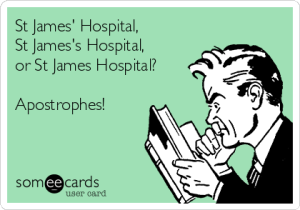Apostrophes
Apostrophes are little punctuation marks that are so often misused. Let’s look at seven purposes.
1. To indicate a missing letter or letters
A contraction is a word where two words are combined into one. One or more letters (and sounds) are dropped and these are indicated by the use of an apostrophe. Examples of these include:
You’re = you are
I’m = I am
We’ll – we will
2. To indicate possession
When something belongs to someone it can be written as: Mary’s bike, or Peter’s boots, or the cat’s whiskers. However, when the pronoun it is used, the apostrophe is omitted. Just as with hers, ours and yours. An example of this: Mary gave the cat its saucer of milk.
It is used in different places for singular and plural possessive cases. The apostrophe is placed before the ‘s’ in singular possessive cases (the cat’s milk) and after the ‘s’ in plural possessive cases (the cats’ milk). Another example of these would be the boy’s bike (one boy) and the boys’ bikes (more than one boy). And another: the bosses’ orders.
Some possessive uses are a little different:
When the possessor is plural, but does not end with an ‘s’, e.g. women, men, children, the apostrophe comes before the ‘s’: women’s, men’s, children’s.
3. To indicate time or quantity
One year’s time, four weeks’ notice, or five dollars’ worth. However, note: two days late.
4. To indicate the omission of figures in dates.
In the year of ’69.
5. To indicate the omission of letters
This can be used as well in old-fashioned English where letters are dropped indicating a different pronunciation.
I s’pose if he came ‘ere, we would expect ‘im to have a membership.
6. To indicate the plural of letters
The n’s and h’s on this old typewriter look the same.
If apostrophes were not used when referring to a’s, i’s and u’s, some confusion could be caused.
7. To indicate the plural of words
If’s, but’s and maybe’s…
One exception is: dos and don’ts, where style guides and usage books don’t agree. Some prefer do’s and don’t’s.
Grammar Girl recommends, “Unless your editor wishes otherwise, if you write books, spell it dos and don’ts; and if you write for newspapers, magazines, or the Web, spell it do’s and don’ts. If you’re writing for yourself, spell it any way you want.”
Evolution of the Apostrophe
Over time, apostrophe use has changed. Where once it was normal to use an apostrophe when writing abbreviations and plural dates, such as CD’s and 1930’s, it is now customary to omit the apostrophe (except in America, where different conventions apply).
Apostrophes in Plural Names
Another confusing area is with possessive plural names that end with ‘s’. Is it more correct to write Jones’ or Jones’s; St James’ Church, St James’s Church, or even St James Church?
Although this is very much a style issue and there are no hard and fast rules, generally you can follow these guidelines:
Names ending in ‘s’ require an apostrophe and second ‘s’ after the name:
- Ross’s car
- Jim Collins’s book
With names from the ancient world, there is no extra ‘s’:
- Achilles’ heel
If the name ends with an “iz” sound, an exception is made:
- Moses’ staff
And an exception is always made for Jesus:
- Jesus’ parables
With names such as St James’ Hospital, it becomes a brand issue, and if they choose to be known as St James Hospital, so be it. Other well-known examples of brands that omit the apostrophe include Deloittes and Harrods.
Sources used for reference:
Eats, Shoots and Leaves – Lynne Truss
Fit to Print – Janet Hughes & Derek Wallace
Grammar Girl: www.quickanddirtytips.com
If you cannot see the comments section, please click on the title of this post.

